Views: 27 Author: Site Editor Publish Time: 2020-12-24 Origin: Site








Pesticides are biologically active materials and potentially hazardous to human health and the environment. Complete decontamination and effective disposal are often very difficult to achieve. One of the most important objectives of good store management is therefore to minimize the occurrence of leaks, spills and outdated stock.
There will occasionally be spills, even in the best run stores, especially where concentrates are repacked and transferred into other containers. Spills must be cleaned up immediately. Always have two people working when handling severe spills. Untreated spills may corrode other containers, become trodden in and contaminate store personnel and may produce toxic or inflammable fumes. If not removed quickly, the spilled chemicals may be absorbed by the floor. Floors therefore need to be made of impermeable (sealed) concrete or other non-absorbent material - removing the contaminated part and replacing it may be the only way to decontaminate absorbent brick, earth or wooden floors.
The spill should not be hosed down as this merely disperses the pesticide over a wider area.
A supply of absorbent sawdust, sand or dry soil should be kept in a container in the store.
Nitrile rubber protective gloves and face-mask should be worn.
Sawdust, sand or dry soil should be scattered over the area of the spill and left for a few minutes to soak up the chemical.
The sawdust, sand or dry soil containing absorbed spilled chemical should be swept or shovelled up and placed in a marked container for disposal (Figure 21)
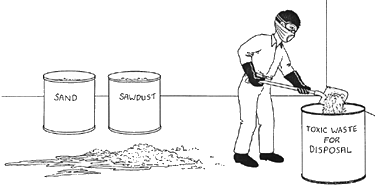
After sweeping, more than once if necessary, a scrubbing brush at the end of a stick should be used to scrub down the area of the spill with water and strong soap or detergent. Excess soapy water should be removed with a rough floor cloth and not hosed down.
Dusts, wettable powders or granules can create dust when swept up without the use of an absorbent material. A supply of absorbent sawdust, sand or dry soil should be kept in a container in the store where they can easily be reached for use in an emergency .
Nitrile rubber protective gloves and face-mask should be worn.
The sawdust, sand or dry soil should be dampened and applied with a shovel over the area of the spill.
The damp sawdust, sand or soil containing spillage material should be swept or shovelled up carefully and placed in a marked container for disposal (Figure 21).
After sweeping, more than once if necessary, a scrubbing brush at the end of a stick should be used to scrub down the area of the spill with water and strong soap or detergent. Excess soapy water should be removed with a rough floor cloth and not hosed down.
Leakage from containers is a major problem in the storage and transport of pesticides (Figure 22). The main cause is rough handling which dents drums, weakens or splits seams and weakens closures (lids, caps and stoppers). Other causes of mechanical damage are puncturing or abrasion during transport when packages and containers rub against one another or against the sides of the truck travelling over uneven surfaces and rough roads.
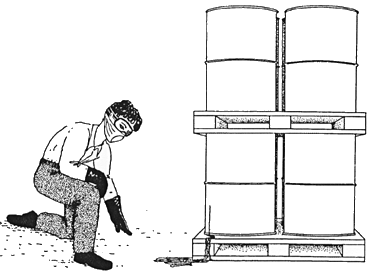
Leaks also result from corrosion of the container, which may be accelerated by mechanical damage (dents may rupture drum linings, for example). Corrosion may start internally, the pesticide itself or its breakdown products being the primary cause. Alternatively, corrosion may begin externally, as a result of rusting in damp storage conditions or contamination from pesticide leaking from nearby containers. Many emulsifiable concentrate (ec) formulations are very corrosive. Some, including monocrotophos, dicrotophos, dichlorvos and phosphamidon are incompatible with steel, so they should be packed in plastic or aluminium containers or in steel containers lined with inner coatings. Some pesticides are dissolved in organic solvents that cannot always be packed in plastic drums. Containers may leak for other reasons; for example, strong sunlight can degrade some plastic containers, including bottles and plastic sacks. Rodents may damage paper, board or fibre containers. Termites may attack paper and card.
Stores should be inspected regularly, at least every two months. Old, rotting and leaking containers are extremely difficult to move safely, so any leaking containers should be dealt with immediately.
Usually, the only way to deal with a leak is to repack the material in a sound container. New containers are preferable, if available, but old containers of various types and sizes may be used for this purpose (old containers are also useful for temporarily storing the products of spills). They must have been thoroughly decontaminated (see next section) and their old labels completely removed.
Pesticides should be repacked in containers made of the same materials as the original containers as some chemicals are not compatible with different materials. Ideally a drum that contained the same product should be used. If unavailable, the container must have been properly cleaned of previous contents to avoid cross-contamination. New labels must be written out immediately with all the information on the old label and fastened securely to the new container. Write the date of repacking (and the date of the original receipt) on the replacement container and ensure that the repacked material is used first.
Many accidents have been caused by empty pesticide containers being used to store water and food. An empty pesticide container can never be cleaned completely of pesticide and should be disposed of in a way that ensures it cannot be used for other purposes. It is, however, wise to retain samples of various types of container, which have been carefully cleaned, in the pesticide store for use in repacking the contents of damaged containers and storing cleaned up leaks and spills prior to final disposal.
Empty containers awaiting disposal should be stored in a special, secure area in the pesticide store to ensure that they are not stolen and used for other purposes.
Empty containers should always be cleaned out, as far as is practicable, before disposal to minimize both hazard and waste of residual pesticide. Containers that have contained ec or wettable powder (wp) formulations should be rinsed with water several times and the rinsings added to the spray tank before it is topped up to the required volume. Following this, containers can be washed out with a mixture of water, detergent and caustic soda (Figure 23). Containers of liquid formulations may be cleaned with kerosene (paraffin) or diesel fuel and the washings (small quantities of about 5 litres) collected for sending later to a central location for disposal by the national authority in a safe and environmentally sound manner.
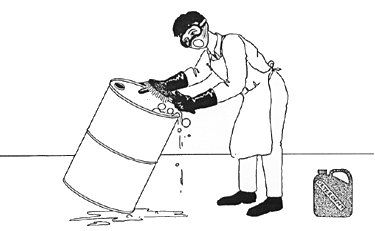
As long as they are not heavily contamined paper, cardboard and fibreboard containers should be burnt on a fire in the open (Figure 24). However, cartons that have contained phenoxy acid herbicides should not be burnt because the combustion products can damage crops at long distances. Highly contaminated cardboard, paper and jute materials should be collected and sent to the central disposal centres along with other toxi waste.
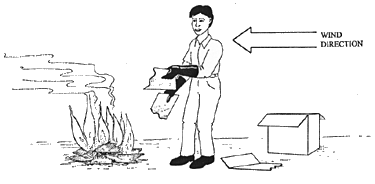
Containers rendered unusable, the products of decontamination procedures, leaks and spills, and container rinsings (where these have not been added to the spray tank) should all be collected for sending later to a central location for disposal by the national authority.
Glass containers should be smashed and steel drums and metal and plastic containers punctured (Figure 25) and crushed (do not puncture aerosol containers) before being sent to a central location for disposal by the national authority.
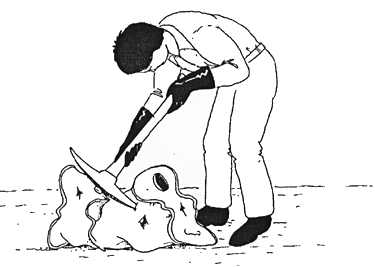
Using pesticides for their intended purposes according to label instructions is the most satisfactory means of disposing of them. For this reason, no more than one year's requirement of pesticides should be ordered and stored, so that none will remain at the end of the product's shelf-life of two years. Only as much pesticide as can be used in a day's operations should be withdrawn from the store and only as much as will go into the sprayer tank should be mixed.
Occasions will arise when it will be necessary to dispose of pesticide concentrates, either because the stock is outdated and has been found to be unusable or because the product is no longer registered for the original purpose. Where very large quantities are to be disposed of, professional advice must be sought from the suppliers and national authority.
If only a few kilograms or litres of pesticide are involved, they should be collected for sending later to a central location for disposal by the national authority. Larger quantities of pesticides are best disposed of by burning in a special incinerator (at 1 200°C) - this does not mean that it would be safe to burn them at a lower temperature on a fire. Incineration requires special equipment with provision for "scrubbing" the combustion products, but this is beyond the capacity of pesticide storekeepers and should be referred to the relevant national authority.
Other means of disposal are to return the pesticide to the supplier or pass it on to a specialist disposal agent elected by the national authority.
Returning the pesticide to the supplier or to the national authority is the safest means of disposal. Disposal involves chemical methods such as alkaline and acid hydrolysis. Oxidation, reduction and spraying on to the ground or allowing to escape into the atmosphere may also be employed, but require specialist skills. The end product in most cases is still toxic. Storekeepers should not become directly involved with pesticide disposal and should refer to the relevant national authority.